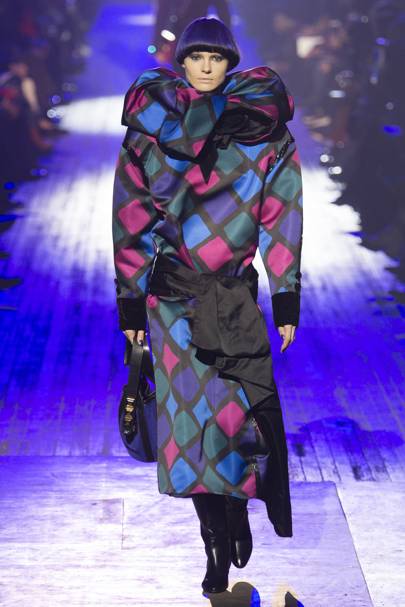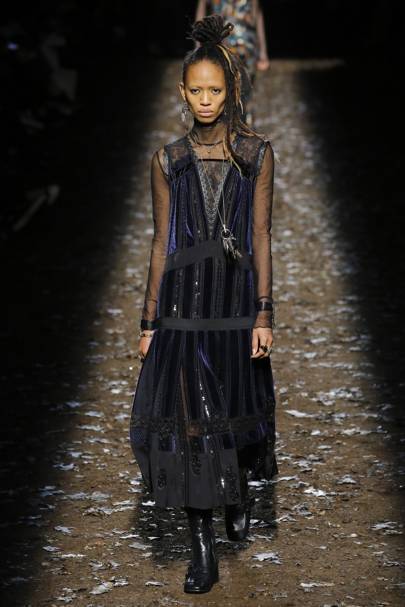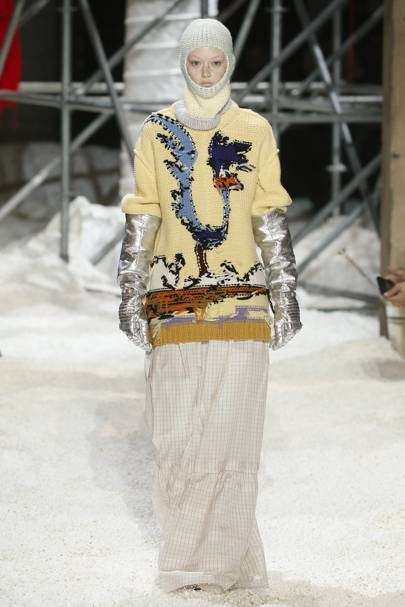The most ironic thing about this New York Fashion Week was designers’ wistful thirst for haute couture on a commercial show schedule that seemed all about survival. Wherever you go in this industry the concerns persist: fashion isn’t selling like it used to, and everyone’s trying to crack the code. New York has always represented commerce rather than creation, so the current industry climate isn’t exactly helping creativity. Except, of course, for those who can’t help themselves.
Ringing out the city’s autumn/winter 2018 shows, Marc Jacobs amplified his ongoing romance with the sculptural drama of savoir-faire in a ceremonious collection that pushed all the polygonal tangents, bending exaggerated sizes in and out of shape on the body. This was basically haute couture on a ready-to-wear runway, and a huge middle finger to the marketeers and their dismal forewarnings. Thank god for designers like Jacobs, who still believe that the fantasy of fashion is what will save us all in the end.

The desire for something more artisanal – often synonymous with eveningwear – penetrated other corners of New York, too. At the democratic Coach, Stuart Vevers talked about interpreting a sense of “dressing up” in his blue-collar take on America. Was he talking about eveningwear? “I can’t even quite say the word!” he laughed. “‘Dressing up’ sounds a little bit more off-hand.” He jazzed up his rock ‘n’ roll prairie look with gothy metallic dresses and accessories, but introduced an increased sense of cut to his silhouette that felt more refined in that evening-y sense. Vevers also collaborated with Colorado-based artist Chelsea Chaplain, whose hand-painted vintage Coach bags he’d found on Instagram. The glamour British Vevers finds in the American heartland is observed by the Flemish Raf Simons, too. In his most accomplished Calvin Klein collection so far, he zoned in on the allure of the frontier dress, adding a sense of design to his work for the brand that went beyond the kind of ‘designer merchandise’ of past seasons.

Handing over the reins of her house to Wes Gordon as she retires, Carolina Herrera finished her farewell show with a finale full of the crisp shirts styled with full taffeta skirts that have come to define both her legacy and the image of practical American glamour. It harked on those no-nonsense values of a time when people behaved a little bit better than they do now, at least in the public forum.
The Monse designers Fernando Garcia and Laura Kim reflected on that same idea, imagining a 1950s wardrobe in a neo-feminist world. “We were kind of laughing at this idea of the 1950s housewife and how different it is from today’s woman,” Garcia said. The women’s freedom movements of the past months – from #MeToo to Time’s Up and the Women’s March in January 2017 following the election of Donald Trump – had to play a major part in the New York shows. Tom Ford’s bold baroque show featured a bag that said “Pussy Power”, while Alexander Wang dedicated his collection to the women he works with.

“I wanted to have variety and the sense that she’s just as comfortable dressed up as she is dressed down,” he explained after the show, which interpreted the corporate women’s wardrobe for a woke world. “And also to knock down the stereotypes of power-dressing, which is really an individual approach; how she sees herself. Just because she’s tough doesn’t mean she can’t be playful. Just because she’s sensual doesn’t mean she can’t have strength. Sexy but on her own terms. She is always in control. She dresses for herself. With all the power comes also the playfulness. I wanted it to feel like there was strength there and discipline but also the sense of wit.” Since she conquered the world with the Spice Girls in the 1990s, Victoria Beckham has been synonymous with Girl Power. Her autumn/winter 2018 collection drew on all those values, albeit for a slightly different audience, in modernist coats and dresses that ha a real sense of realness to them. “When I first started it was about the empowerment of a woman and her silhouette,” Beckham said.

The desire for something more artisanal – often synonymous with eveningwear – penetrated other corners of New York, too. At the democratic Coach, Stuart Vevers talked about interpreting a sense of “dressing up” in his blue-collar take on America. Was he talking about eveningwear? “I can’t even quite say the word!” he laughed. “‘Dressing up’ sounds a little bit more off-hand.” He jazzed up his rock ‘n’ roll prairie look with gothy metallic dresses and accessories, but introduced an increased sense of cut to his silhouette that felt more refined in that evening-y sense. Vevers also collaborated with Colorado-based artist Chelsea Chaplain, whose hand-painted vintage Coach bags he’d found on Instagram. The glamour British Vevers finds in the American heartland is observed by the Flemish Raf Simons, too. In his most accomplished Calvin Klein collection so far, he zoned in on the allure of the frontier dress, adding a sense of design to his work for the brand that went beyond the kind of ‘designer merchandise’ of past seasons.
In Simons’ show notes the word “couture” appeared alongside “pioneer, Western, heroes, Hollywood, Civil War, cotillion,” and “New World.” His show radiated the mood of defiance against the current American establishment you feel all over New York. The word “safe,” Simons said of the collection, “was an important reference for the feeling.” You could interpret that literally in the colossal volumes that framed it: huge torn knits, armour-like knitted breastplates, oversized men’s coats, orange reflector suits, and protective utilitarian gloves and wellies. Or, you could take it as an acute desire for some sanity at the top of the political pyramid. You could certainly detect in the New York shows a longing for a more civilised and polite mentality. Tory Burch referenced the laid-back elegance of Lee Radziwill and covered her show venue in carnations, which she referred to as “humble”. Eckhaus Latta proposed a glamorous new take on their woke aesthetic in a collection that also echoed those haute couture principles.

Handing over the reins of her house to Wes Gordon as she retires, Carolina Herrera finished her farewell show with a finale full of the crisp shirts styled with full taffeta skirts that have come to define both her legacy and the image of practical American glamour. It harked on those no-nonsense values of a time when people behaved a little bit better than they do now, at least in the public forum.
The Monse designers Fernando Garcia and Laura Kim reflected on that same idea, imagining a 1950s wardrobe in a neo-feminist world. “We were kind of laughing at this idea of the 1950s housewife and how different it is from today’s woman,” Garcia said. The women’s freedom movements of the past months – from #MeToo to Time’s Up and the Women’s March in January 2017 following the election of Donald Trump – had to play a major part in the New York shows. Tom Ford’s bold baroque show featured a bag that said “Pussy Power”, while Alexander Wang dedicated his collection to the women he works with.

“I wanted to have variety and the sense that she’s just as comfortable dressed up as she is dressed down,” he explained after the show, which interpreted the corporate women’s wardrobe for a woke world. “And also to knock down the stereotypes of power-dressing, which is really an individual approach; how she sees herself. Just because she’s tough doesn’t mean she can’t be playful. Just because she’s sensual doesn’t mean she can’t have strength. Sexy but on her own terms. She is always in control. She dresses for herself. With all the power comes also the playfulness. I wanted it to feel like there was strength there and discipline but also the sense of wit.” Since she conquered the world with the Spice Girls in the 1990s, Victoria Beckham has been synonymous with Girl Power. Her autumn/winter 2018 collection drew on all those values, albeit for a slightly different audience, in modernist coats and dresses that ha a real sense of realness to them. “When I first started it was about the empowerment of a woman and her silhouette,” Beckham said.
“It feels like an evolution of where I started with certain pieces: a nice neat shoulder, a nipped-in waist, and lots of layering.” In its intricacy, her collection also nodded to the appreciation of the artisanal that sieved through New York despite fashion’s challenge to break with declining retail figures. It was something Michael Kors may have found the solution to in a show that mixed that sense of Park Avenue dressing with New York streetwear and all the positive messages that echoed through New York. “I’ve always believed it was my job to take someone who feels confident and make them more confident. And if you’re not as confident, how do I let you feel confident? Now more than ever we need the power of the right things in our closet to get on with this complicated life and juggle a lot of things, quite frankly,” the designer said. His solution was to create the definitive wardrobe for women: the every-wardrobe, if you will, for the everywoman. “I believe that fashion can make you feel better, so we’re gonna have a love letter to people who love fashion, who aren’t down on fashion, who have fun with it.”

No comments:
Post a Comment